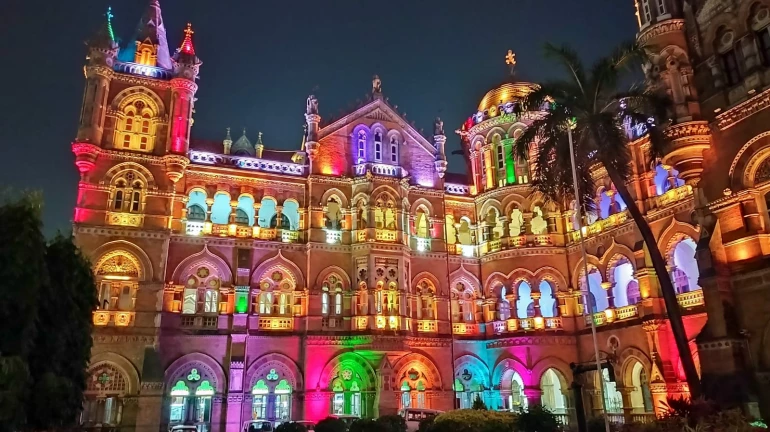
The first train in Asia ran between Mumbai and Thane on Saturday, April 16, 1853. Indian Railways enters into 170th year of service to the Nation from April 16 2022.
In 1900, the Indian Midland Railway Company was merged with the Great Indian Peninsula Railway the predecessor of the Central Railway and its frontiers were extended from Delhi in the North, Kanpur and Allahabad in the North-east and Nagpur in the East to Raichur in the South-east. Thus, the connection from Bombay was obtained to almost all parts of India.
At present, there are five divisions on Central Railways i.e. Mumbai, Bhusaval, Nagpur, Solapur and Pune. Central Railway's network is spread over 4,183 route km in the states of Maharashtra, Madhya Pradesh and Karnataka.
To commemorate the first journey of Railways in India, ‘Azadi ka Amrit Mahotsav’, commemorating the Railway Week and World Heritage Day (April 18 2022), Central Railway is presenting a unique light and sound cum performance show on the Chhatrapati Shivaji Maharaj Terminus (CSMT) heritage building a UNESCO Heritage Site.
Anil Kumar Lahoti, General Manager, Central Railway said that to celebrate the heritage and architecture of CSMT they are staging a unique light and sound cum performance show in the background of this building.
The unique light and sound performance show are scheduled this weekend. The show would be depicting its history through the various emotions of the nine Rasas of ‘Natyashastra’.
Now new sparkle of the theme lighting system at the CSMT heritage building can be seen through a change in the technology used to light the iconic structure in the recent past. An upgraded version of LED which has more than a million combinations of lights has been used to illuminate the station building. The 134-year-old CSMT lit up with around 1100 lights. Out of these 1100, the brightness of over 450 lights has decreased due to ageing. All these 450 lights have been replaced with new technology LED lights.
“Navarasangam – Ek Gatha CSMT ki”, showcases the Indian cultural canvas by 70 artists who are Railway employees. The original audio track has also been created by a team of Railway artists. The artists would be performing under the aegis of the Central Railway Cultural Academy having inclusive participation from Headquarters, Divisions and Workshops.
Background:
CSMT, the spectacle that witnessed many a milestone in its existence
The present-day Headquarters Building of the Central Railway popularly known as Victoria Terminus (now Chhatrapati Shivaji Maharaj Terminus) is an architectural marvel. This magnificent monument was originally planned as the office of GIP Railway. This was designed by Frederick William Stevens, a consulting architect. The construction started in 1878 and on Jubilee Day in 1887, it was named after Queen Empress Victoria. Thus, taking almost a decade to build it at a princely sum of INR 16,13,863/- Stevens designed the monumental Terminus which was the largest building then erected in Asia.
The Victoria Terminus was designed in the Gothic style adapted to suit the Indian context. The Gothic style, offering the colour and complexity of Mughal and Hindu architecture, harmonized and most effectively made reference to the indigenous preference for ornamentation, making it the right choice of style for Victoria Terminus. The building is symmetrical about the east-west axis.
The crowning point of the whole building is the central main dome carrying up as a finial at its apex, a colossal 16'-6'' high figure of a lady pointing a flaming torch upwards in her right hand, and a spoked wheel low in the left hand, symbolizing 'Progress'. This dome has been reported to be the first octagonal ribbed masonry dome that was adapted to an Italian Gothic style building.
The first important modification came in 1929. The former station, which adjoined it, was reserved for suburban traffic and used to have 6 platforms. In March 1929, when the Governor, Sir Frederick Sykes, opened the remodelled VT the station was remodelled to have 13 platforms the last five being exclusively used for through trains to and from various parts of India.
With the increase in suburban Passenger traffic, first, a double discharge platform was provided in May 1990 and by January 1991 all the suburban platforms were made double discharge. Further additions were made in February 1994 by making the total number of platforms 15. In March 1996, the station was renamed Chhatrapati Shivaji Terminus, and the building was listed as a World Heritage monument by UNESCO in July 2004 as an outstanding example of late 19th Century architecture. With a view to accommodate 24 coach trains platforms, 16 to 18 were constructed with spacious parking and entry from P D’Mello Road in September 2007. It was renamed Chhatrapati Shivaji Maharaj Terminus in July 2017.
Present-day CSMT station:
The CSMT is the first railway station in Maharashtra to get IGBC Gold certification in 2021. It is also an Eat Right certified station. Daily about 48 pairs of long-distance trains and about 1200 suburban trains are handled at CSMT station.
Also Read: Central Railway: ‘One Station One Product’ Initiative At CSMT Will Sell "This" Product





